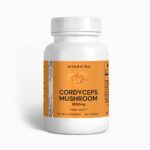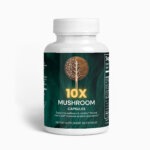
“Finding Fungi: When to Find Lion’s Mane Mushroom”
Embark on a mycological adventure that defies the ordinary—quest for the extraordinary Lion’s Mane Mushroom. Hidden within the wooded embrace of nature, this culinary and medicinal marvel awaits those with a keen eye and a yearning for discovery. The Lion’s Mane, with its cascading spines and ethereal appearance, is not merely a fungus; it is a treasure trove of health, a symphony of earthy flavors, and a testament to the intricate tapestry of our ecosystem. As seasons shift their colors, the time to forage this gift of the woods draws near, and with the right knowledge, you can unlock the secrets of when to find the Lion’s Mane Mushroom. Join us as we into the world where the forest floor whispers tales of healing and gourmet delight, guiding you to the perfect moment to uncover these hidden gems. Whether you’re a seasoned forager or a curious newcomer, get ready to be persuaded by the allure of the wild, where nature’s bounty waits for the mindful harvester. Let the hunt begin!
Table of Contents
- Embarking on the Mycological Quest: The Prime Seasons for Lion’s Mane
- Unlocking the Secrets of Habitat: Where Lion’s Mane Mushrooms Thrive
- Early Bird or Night Owl: Decoding the Best Time of Day for Foraging
- Weather Patterns and Fungal Friends: Understanding Lion’s Mane Growth Cycles
- The Forager’s Toolkit: Essential Gear for Hunting Lion’s Mane
- Beyond the Hunt: Cultivating Lion’s Mane Mushrooms at Home
- Nature’s Bounty: Safely Identifying and Harvesting Lion’s Mane
- Preservation Techniques: Keeping Your Lion’s Mane Mushrooms Fresh
- From Forest to Kitchen: Creative Culinary Uses for Lion’s Mane
- Conservation is Key: Sustainable Foraging Practices for Mushroom Enthusiasts
- Q&A
- The Way Forward
Embarking on the Mycological Quest: The Prime Seasons for Lion’s Mane
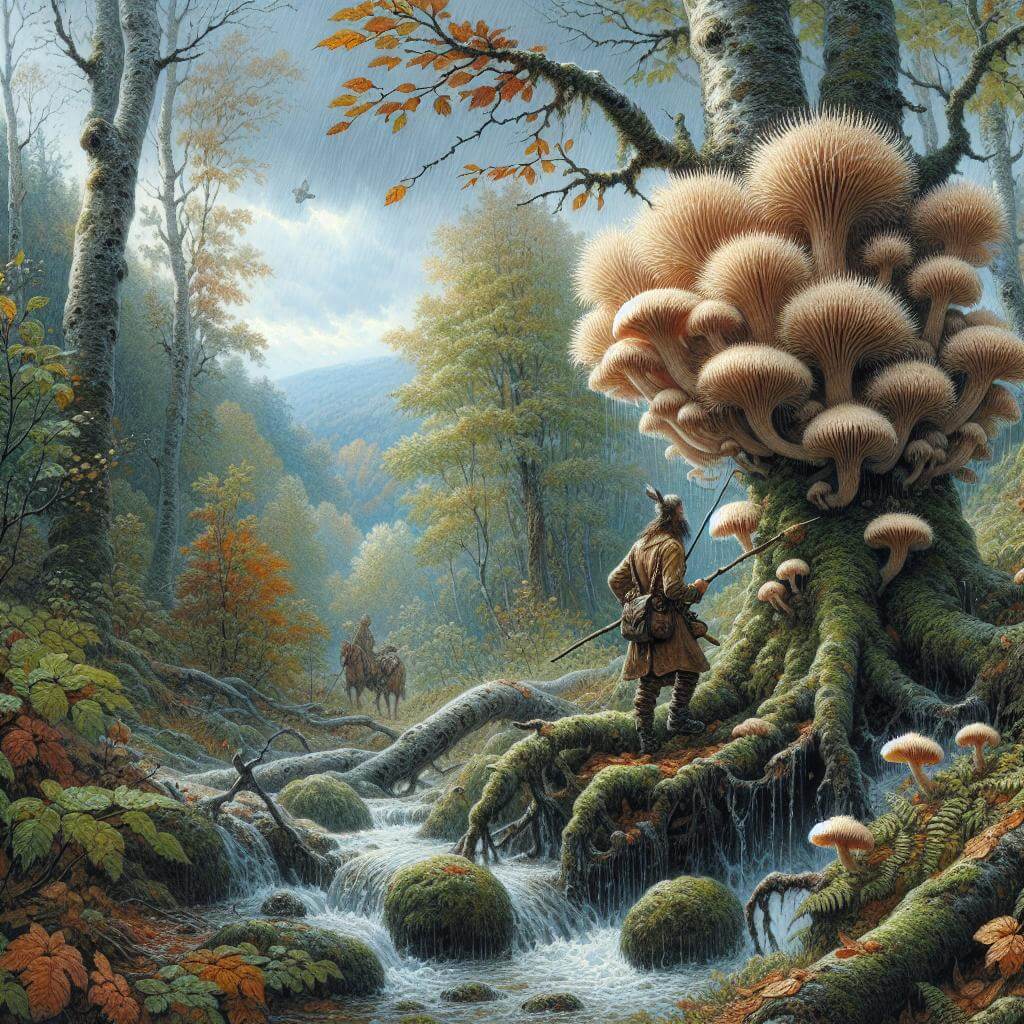
Venturing into the woods with a basket in hand, hopeful foragers often dream of encountering the illustrious Lion’s Mane mushroom. This shaggy, white cascade of fungal tendrils not only bewitches with its unique appearance but promises a bounty of health benefits. The seasoned seeker knows that timing is everything: these bearded beauties have their own calendar, and tapping into its rhythm is key to a successful harvest.
Fall’s Fungal Finale: As autumn paints the forest with fiery hues, Lion’s Mane mushrooms grace the forest stage. From late August through November, these fungi find their stride, blossoming on hardwoods like a natural ornamentation. Their preference for cooler temperatures and the increased precipitation of fall creates a perfect mycological storm. Keep your eyes peeled on wounded or dying trees, as these are the stages upon which Lion’s Mane performs its captivating dance.
Spring’s Mycelium Awakening: Don’t despair if the chill of winter has left your forage basket wanting. Lion’s Mane offers a second act as the warmth of spring breathes life back into the forest floor. From late March to the end of May, watch as these mushrooms take advantage of nature’s rejuvenation. The fresh foliage and springtime sap flow lend vigor to the Lion’s Mane, providing foragers another chance to stumble upon this brain-boosting delicacy.
To the strategist, understanding your local climate’s nuances can transform your foray from hopeful to bountiful. Consider the following guidelines as you chart your quest for Lion’s Mane:
| Season | Sighting Likelihood | Preferred Conditions |
|---|---|---|
| Early Fall | Moderate | Start of cooler weather, dying trees |
| Mid to Late Fall | High | Decreased temperatures, higher moisture levels |
| Late Spring | Moderate to High | Warming trends, spring tree sap |
Keep in mind, these are merely nature’s soft suggestions. Microclimates and unexpected weather patterns can extend or shift the Lion’s Mane’s stage time. Engage with local foraging communities, share sightings, and celebrate the seasonal performance of this majestic mushroom. With each outing, your attunement to nature’s nuances deepens, turning the art of mushroom foraging into a keenly orchestrated hunt. So lace up your boots and tap into the forest’s whispers—Lion’s Mane awaits.
Unlocking the Secrets of Habitat: Where Lion’s Mane Mushrooms Thrive
Delving into the forest’s natural pantry reveals a culinary and medicinal gem — the lion’s mane mushroom. Renowned for its captivating, shaggy appearance, reminiscent of a lion’s regal mane, this delectable fungus has a unique affinity for the ancient arms of hardwood trees. Deciduous guardians, such as beeches and maples, serve as natural hosts, offering up their trunks for this mushroom to flourish.
Enthusiasts and foragers must tune into the rhythm of the seasons to discover when these treasures are ripe for harvesting. As autumn dresses the forest in hues of gold and amber, lion’s mane mushrooms begin their emergence. This period, from late summer to fall, is when they reach their peak of growth, often continuing their life cycle until the first frost whispers through the woodland.
- Optimal Climate: Cool and moist environments
- Preferred Trees: Aging hardwoods with wounds that allow entry
- Seasonal Availability: Mainly autumn, with some variances by region
| Region | Harvesting Season |
| North America | September – November |
| Europe | October – December |
| Asia | Varies considerably by locale |
Not all forests are created equal when it comes to nurturing lion’s mane mushrooms. Those who seek its wisdom must journey to higher elevations or find secluded woods where humidity lingers like a constant companion. It’s in these microhabitats that lion’s mane thrives, often basking in the subdued light that filters through the dense canopy overhead. By understanding and respecting this natural sanctuary, we can forage responsibly, ensuring that the lion’s mane remains a sustainable resource for generations to come.
Early Bird or Night Owl: Decoding the Best Time of Day for Foraging

Are you an early riser ready to bask in the dewy glow of dawn, or do you prefer the stillness that comes with twilight? When it comes to foraging Lion’s Mane mushrooms (Hericium erinaceus), understanding the rhythms of nature could be your secret to a bountiful harvest. While these unique mushrooms don’t strictly adhere to our human schedules, there are certain times of day when your chances of success may increase.
Advantages of the Early Hours: As the sun peeks over the horizon, the forest awakens with opportunities. Morning foragers often find that the overnight moisture helps in identifying fresh growths, as the dew settles on the delicate spines of the Lion’s Mane, making them glisten amidst the woodland understory. But there’s more to mornings than just moisture:
- The air is cooler, which can be a blessing during the warmer seasons.
- Wildlife that might compete for your prize tends to be less active.
- There’s something inherently tranquil about being surrounded by nature’s morning chorus, as it seems to promise a good start to any foraging adventure.
However, the nightfall narrative has its advocates too. Some steadfast foragers argue that the later hours of the day have their perks. Reduced human activity as dusk approaches means quieter woods and fewer disturbances. The evening air, rich with the day’s warmth and the aroma of the earth cooling down, may carry the distinct fragrant hints of fungi, guiding you to hidden clusters of Lion’s Mane nestled against tree trunks and fallen logs.
| Early Morning | Twilight |
| Fresh Growth Visibility | Subtle Fungal Scents |
| Cooler Temperatures | Peaceful Foraging |
| Less Wildlife Competition | Warmth-Aided Spore Release |
Ultimately, whether you’re up with the larks or roaming with the fireflies, finding Lion’s Mane mushrooms can be a fulfilling pastime. Experiment with different times of day to discover what works best for you — and for the mushrooms. Keep a foraging journal to note the conditions under which you’ve found the most success. With patience and persistence, you’ll develop your own sense of the perfect time to embark on your mycological quests.
Weather Patterns and Fungal Friends: Understanding Lion’s Mane Growth Cycles
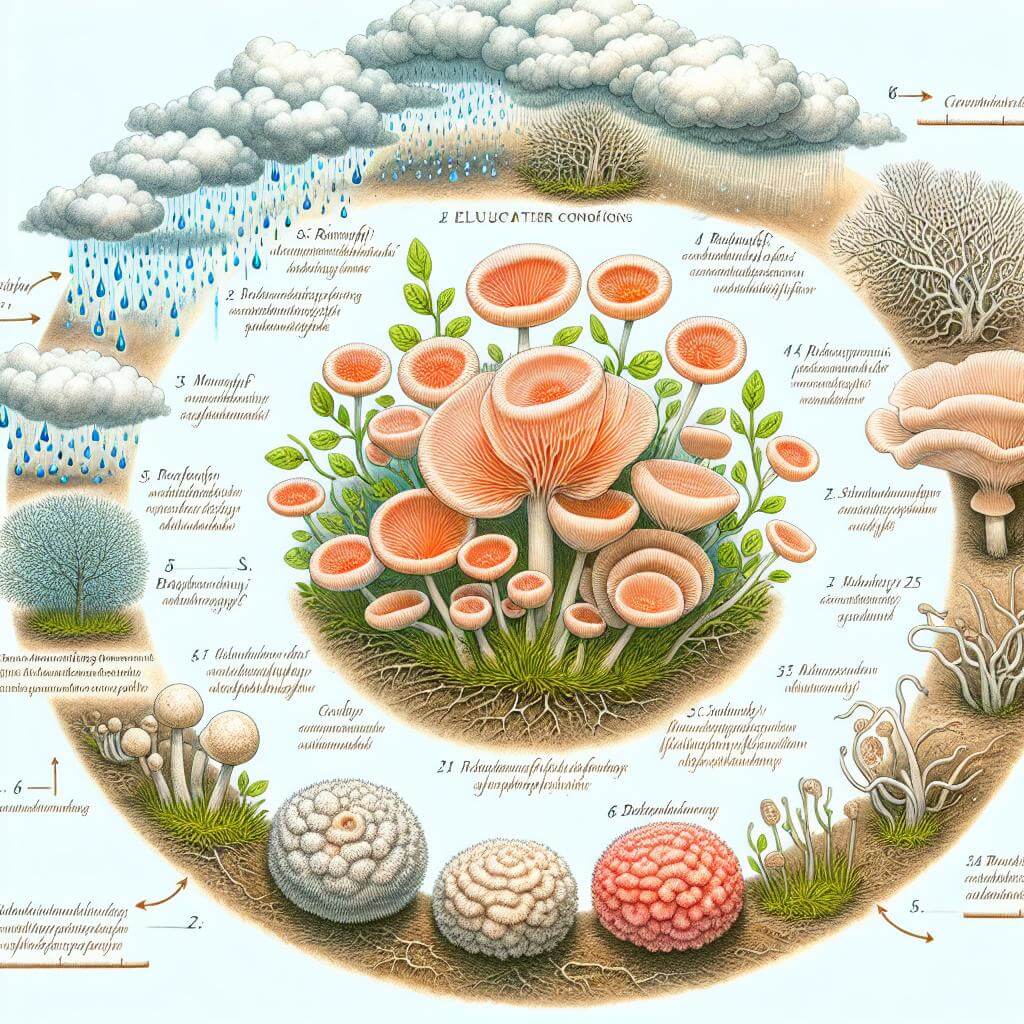
If you’re on the hunt for the elusive yet sought-after Lion’s Mane mushroom (Hericium erinaceus), timing and climate are your secret map to treasure. This remarkable fungus, resembling a white waterfall of cascading spines, is not only a culinary delight but also a treasure trove of medicinal properties. Here’s what you need to know about the whims of weather that guide its growth.
Embracing the Cold: Lion’s Mane mushrooms have a particular fondness for the chill of fall and the onset of winter. As the leaves begin to don their fiery hues and the air takes on an invigorating crispness, these fungi start their magical emergence. They prefer temperatures ranging from 15°C to 20°C (59°F to 68°F), and your best bet for finding Lion’s Mane is during the months of late August to November. Keep your eyes peeled on hardwoods, as they especially love oak, beech, and maple.
- Search in the cool morning hours
- Look for hardwood hosts
- Monitor the temperature dips
Moisture is another key player in the Lion’s Mane saga. A consistent level of moisture without being waterlogged creates the perfect atmosphere for these fungi to thrive. This is why they pair the autumn rains with their growth spurt. After a good rainstorm, give the sun a day to peek out and warm the forest floor before venturing out; this moment can be ideal as the mycelium eagerly pushes growth to capitalize on the dampened, nutrient-rich environment.
| Season | Optimal Temperature | Moisture Level |
|---|---|---|
| Fall/Winter | 15°C - 20°C (59°F – 68°F) | Consistent, not waterlogged |
| Spring/Summer | Above 20°C (68°F) | Low |
Keep in mind, just as a chef finesse the flavors in their dish, the subtleties of the environment can finesse the frequency and size of Lion’s Mane growths. While the general conditions are a solid guide, be adaptive in your search. Pay attention to local weather patterns, logging regions with ample fungus-friendly trees for return visits, and always respect the habitat—harvest sustainably and leave some behind to ensure future growth. To find Lion’s Mane, you must think like Lion’s Mane—become one with the forest, and you will learn its secrets.
The Forager’s Toolkit: Essential Gear for Hunting Lion’s Mane

Embarking on a quest for the elusive Lion’s Mane mushroom, a treasure trove of neurological benefits, requires more than enthusiasm. A forager’s success hinges upon the right gear, as much as timing and location. Let’s fill that backpack with some indispensable tools to elevate your foraging game to masterclass levels.
Sturdy Footwear: Prepare to tread through a variety of terrains, from damp forest floors to rugged underbrush. Quality boots with solid grip and ankle support are non-negotiable – they safeguard your strides as you navigate the wild in search of your fungal prize.
- Durable, waterproof boots or hiking shoes
- Extra padding for comfort over long distances
- Slip-resistant soles for stability on wet ground
Navigational Aids: The hunt for Lion’s Mane often leads adventurers off the beaten path. A reliable compass coupled with detailed maps or a GPS device ensures you can focus on foraging without losing your way. A charged smartphone with offline maps is also advisable as a backup measure.
| Item | Use |
| Compass | Orientation |
| GPS device | Precise tracking |
| Maps | Local terrain navigation |
Gathering Tools: Once you’ve spotted your target, delicate handling is key. A sharp knife is essential for cutting the mushroom at the base without damaging its toothy tendrils. Pair this with a soft brush to gently clean your find on-site, avoiding the need to remove soil back at home.
- Sharp knife or scissors for harvesting
- Gentle brush for dirt removal
- Basket or mesh bag for storage (allows spores to spread, aiding conservation)
To fully enjoy the rewards of your foraging journey, these tools are just the beginning. Equipped with the right gear, your hunt for Lion’s Mane mushrooms will not only be productive but also an exercise in ecological mindfulness and a step closer to nature’s rhythm.
Beyond the Hunt: Cultivating Lion’s Mane Mushrooms at Home
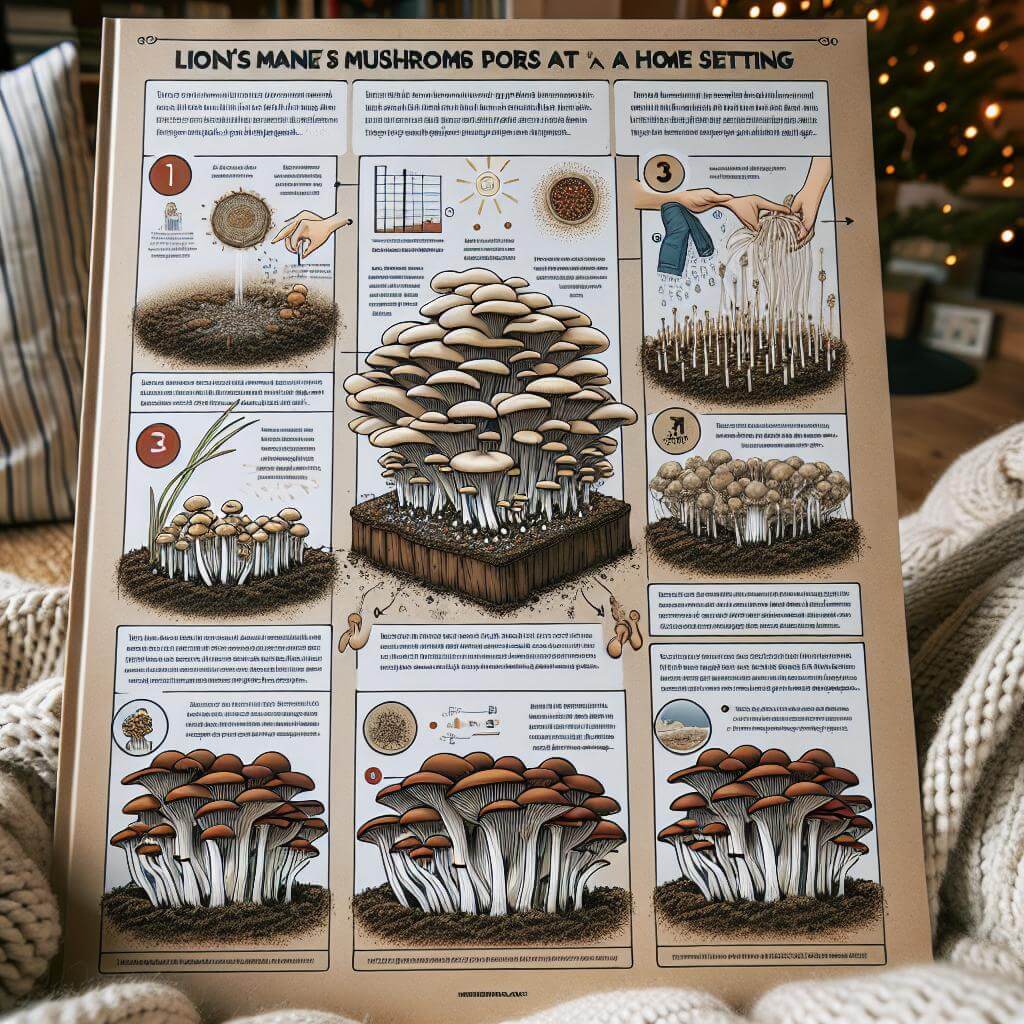
If you’re enchanted by the idea of harvesting your own brain-boosting Lion’s Mane mushrooms but aren’t keen on foraging in the wild, fear not! You can cultivate these magnificent fungi in the comfort of your own home. With a few essential items and some patience, you’ll transform into a mycological maestro in no time.
First things first, let’s talk substrate. Lion’s Mane mushrooms thrive on hardwood sawdust, supplemented with organic brown rice flour for extra nutrition. You’ll need to procure inoculum, which is essentially the mushroom spawn. This can be purchased online or from a trusted local supplier. Unlike wild harvesting, controlling your growing environment safeguards against unwanted contaminants and optimizes yield.
- – Hardwood sawdust
- – Organic brown rice flour
- – Inoculum (mushroom spawn)
- – Sterilized bags or jars
- – A spray bottle for misting
Setting the stage for growth involves a bit of preparation. Mix your sawdust and rice flour in a sterilized bag or jar, introduce your inoculum, and seal it up. This mini-ecosystem then needs to be kept at an optimal temperature range of 65-75°F (18-24°C). With proper moisture, darkness, and a touch of love, you’ll witness the mycelium’s magic as it colonizes the substrate over several weeks.
| Starter | Optimal Temperature | Colonization Time | Harvest Period |
|---|---|---|---|
| Day 1-3 | 70°F (21°C) | Week 1-2 | Weeks 3-6 |
| Day 4-7 | 75°F (24°C) | Week 2-4 |
Once colonization is complete, it’s time to introduce fruiting conditions. A daily misting routine will maintain the humidity required for Lion’s Mane to flourish. You’ll want to expose them to indirect light and fresh air to encourage fruiting. In a few weeks, you’ll be greeted by the distinctive, cascading icicle-like spines — a sign that your Lion’s Mane is ready to harvest and add an earthy, lobster-like flair to your culinary creations.
Nature’s Bounty: Safely Identifying and Harvesting Lion’s Mane

Delving into the wild to forage for your own delicacies is a rewarding experience, not least when you’re on the hunt for Lion’s Mane, a prismatic treasure trove of flavor and nutrition. These distinctive fungi, resembling a cheerleader’s pom-pom, thrive in the cool, damp embrace of hardwood forests. But before you head out with basket in hand, it’s vital to know how to correctly identify the Lion’s Mane from its look-alike counterparts.
- Search primarily on dead or dying hardwoods, such as oak, walnut, or beech.
- The genuine article has cascading, icicle-like spines, not cap-and-stem structures.
- Its color can range from pure white when young to a more yellowish hue as it ages.
- No poisonous look-alikes exist, but always double-check with a reliable guide or experienced forager.
Once you’ve got your sights on a genuine specimen, harvesting is a delicate operation. Use a knife to gently cut the mushroom at its base, careful not to damage the tree or the mycelium from which it springs forth. By taking only what you need, you ensure future foragers will also enjoy Nature’s provisions.
| Month | Likelihood of Finding Lion’s Mane |
|---|---|
| Late Summer | Emerging |
| Autumn | Peak Season |
| Early Winter | Occasional Finds |
Harvesting isn’t merely about what you find, but also when. Aligning your search with the right season amplifies your chances of success. Lion’s Mane typically makes its grand entry in late summer and graces the forest through to early winter. But remember, the woods are more than a pantry—they’re a living, breathing ecosystem. Take a moment to be still and savor the symphony of rustling leaves and distant bird calls as you forage with respect and gratitude for the abundant cornucopia that is nature’s bounty.
Preservation Techniques: Keeping Your Lion’s Mane Mushrooms Fresh
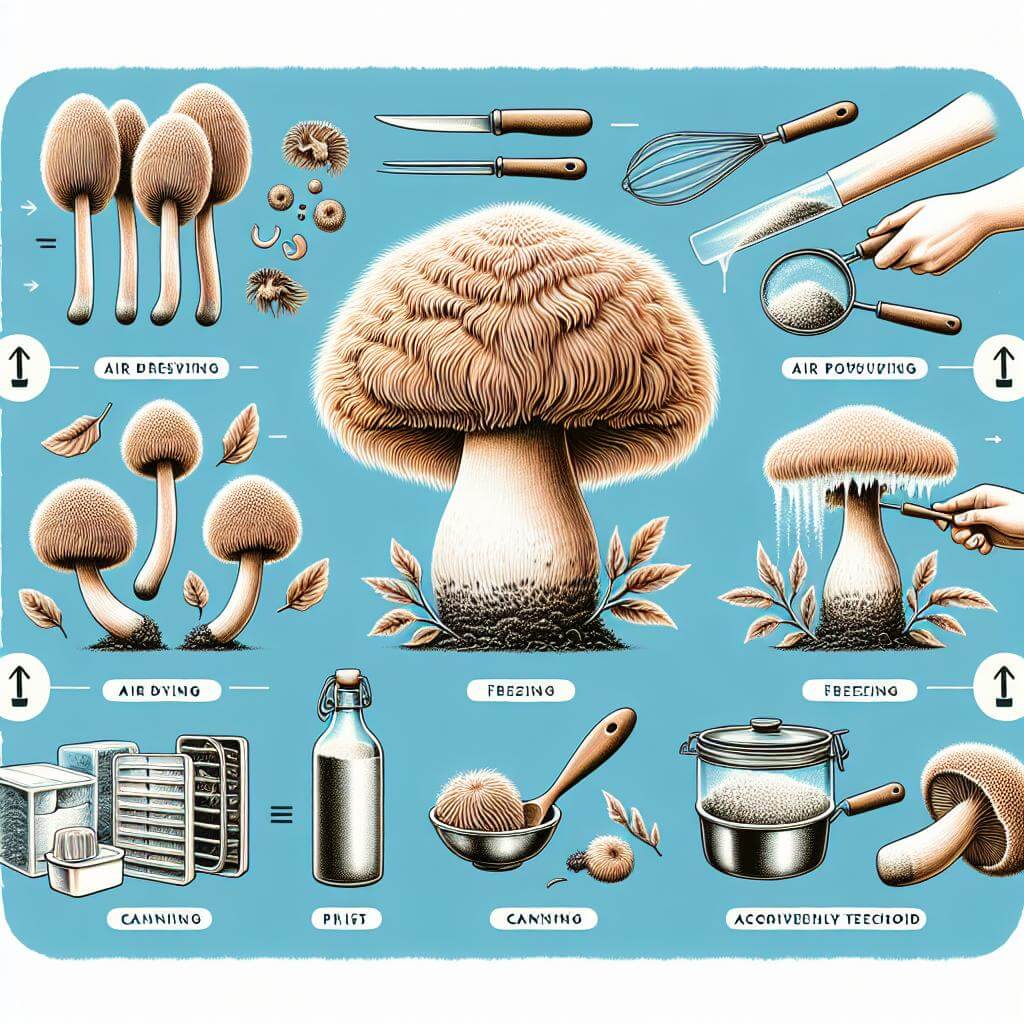
Once you’ve had the good fortune to harvest or procure these delectable fungi, ensuring their freshness is key to savoring their unique flavor and health benefits. In the world of culinary delights, Lion’s Mane mushrooms are praised not just for their taste but also for their remarkable shelf-life, that is, when preserved correctly. Let’s into some effective methods to keep those mushrooms in prime condition.
Starting with the basics, refrigeration is a simple yet effective strategy. Gently wrap your Lion’s Mane mushrooms in a paper towel to absorb any excess moisture and place them in an open container or a breathable bag. Keep in mind that trapped moisture is the enemy of freshness, so avoid airtight plastic bags. Refrigeration can keep your mushrooms crisp and delicious for up to a week.
- Cool Dry Storage: If you’re not ready to use your Lion’s Mane right away, consider a cool, dry storage method. Use a mesh or breathable cloth bag and hang them in a cellar or similarly cool area of your home. Ensure they’re not exposed to direct sunlight or heat sources.
- Freezing: For long-term storage, freezing is an ultimate go-to. You can either freeze them whole or slice them up. Flash freeze the slices on a tray before transferring to a container – this prevents them from clumping together.
- Drying: Dehydrating Lion’s Mane mushrooms is an excellent preservation method, intensifying their flavor as well. Once dried, they can be rehydrated in water or added directly to soups and stews.
Dehydrating your mushrooms can transform them into a convenient, shelf-stable ingredient. Prepare them in thin slices, spread evenly on a dehydrator tray, and set the temperature between 125-135 degrees Fahrenheit. Your mushrooms will be ready when they’re completely dry and somewhat crumbly to the touch. Store in an airtight container, away from light, and they’ll keep for several months, retaining their nutritional value.
| Preservation Method | Shelf Life |
| Refrigeration | Up to 1 week |
| Cool Dry Storage | Several days |
| Freezing | Several months |
| Dehydrating | 6+ months |
Embrace these preservation techniques, and you’ll maximize the life and flavor of your Lion’s Mane mushrooms. By treating them with care, you can enjoy their earthy, seafood-like taste and brain-boosting benefits well beyond the season. Good preservation isn’t just practical; it’s an art – one that allows the bounty of nature to grace your table time and time again.
From Forest to Kitchen: Creative Culinary Uses for Lion’s Mane

Embark on a culinary adventure right in your own kitchen with the extraordinary Lion’s Mane mushroom. This unique fungus is not just a delight for foragers but a boon for gastronomes craving a twist on traditional recipes. Its meaty texture and umami flavor profile make it an excellent choice for vegetarians and meat-eaters alike, and it’s easy to see why it’s often used as a substitute in dishes typically dominated by seafood or poultry.
For starters, consider the Lion’s Mane ‘Crab’ Cake. This little wonder mimics the delicate texture of crab, offering a sustainable alternative that will charm even the staunchest seafood aficionados. Simply shred the mushroom, mix with your binding ingredients, and sauté to a golden crisp. You can serve these savory cakes over greens or with a side of zesty remoulade sauce for an extra kick.
- Herbed Lion’s Mane Roast: Marinate thick slices with garlic, rosemary, and thyme, then roast until tender.
- Mushroom Risotto: Stir into creamy Arborio rice, adding white wine and Parmesan for a rich finish.
- Sautéed on Toast: Quick and elegant, browned mushrooms atop crusty bread make for a simple, yet luxurious breakfast.
Consider experimenting with the following table of ingredients to complement the subtle, seafood-like flavor of Lion’s Mane:
| Ingredient | Flavor Profile | Dish Ideas |
|---|---|---|
| Garlic | Earthy, Pungent | Sautés, Soups |
| Lemon | Bright, Citrusy | Pasta, Dressings |
| Fresh Herbs | Aromatic | Roasts, Stews |
| White Wine | Fruity, Acidic | Risottos, Sauces |
Whether incorporated into sophisticated appetizers or served as the star of the main dish, Lion’s Mane is a versatile ingredient that brings forest-fresh flavor straight to your dining table. Next time you uncover this gem in the wild, or at your local farmer’s market, don’t hesitate to treat your taste buds to its incredible possibilities. Explore, invent, and most importantly, enjoy every bite of your forest-harvested treasure.
Conservation is Key: Sustainable Foraging Practices for Mushroom Enthusiasts

As you venture into the wild in search of the delectable Lion’s Mane mushroom, it’s vital to uphold the principles of sustainable foraging. This ensures that our forests remain lush and the fungi flourishing for generations of foragers to come. Always forage with the future in mind; be gentle with the ecosystem, taking only what you need and leaving plenty behind for both wildlife and other mushroom aficionados.
Begin your journey by familiarizing yourself with the local biodiversity. Taking a moment to understand which species are at risk can prevent accidental harm to vulnerable fungi. Forage responsibly by adhering to these guidelines:
- Never harvest rare or endangered species.
- Harvest mushrooms in a way that allows for regrowth, such as cutting rather than uprooting.
- Mind your footsteps to avoid damaging unharvested mushrooms and their mycelium networks.
Timing is crucial when scouting for Lion’s Mane. This fungus prefers the cooler and damper days of late summer through to fall, so mark your calendars. Moreover, keeping track of your finds can benefit both your future harvests and the broader foraging community. A simple foraging diary helps observe and preserve the delicate balance of nature.
| Month | Observation |
|---|---|
| August | Initial sightings of young fruiting bodies |
| September | Peak of mature Lion’s Mane |
| October | Spores dispersing, good for next season’s growth |
Lastly, sustainable foraging is about passing on knowledge as well as preserving nature. Share your insights and practices with newcomers. Encourage courses and guided walks with experts who can instill a sense of stewardship in others. By doing so, you’re not just collecting mushrooms; you’re helping to cultivate a community deeply rooted in respect for the natural world.
Q&A
**Q: What mystical creature shares its name with a sought-after culinary and medicinal treasure in the forest?**
A: If you’re conjuring images of noble lions, you’re on the right path, but this particular treasure is the *Lion’s Mane Mushroom*! A culinary gem and a nootropic powerhouse, this unique fungus is as enchanting as a fable but as real as the earth beneath your feet.
**Q: When exactly do the forests bestow upon us the gift of Lion’s Mane Mushrooms?**
A: The prime time for foraging these shaggy delights, looking much like a lion’s mane (hence the name), is late summer to fall. However, the mushrooms have been known to make surprise appearances throughout winter and spring, making every walk in the woods a potential treasure hunt.
**Q: Are Lion’s Mane Mushrooms playing hard to get, or will I stumble upon them on any given hike?**
A: While they do love to nestle on hardwoods like oak and beech, they can be a touch reclusive, opting for wounded or fallen trees. Your quest for Lion’s Mane might require a keen eye, but with a bit of patience and forest savvy, you can spot these beauties as they grace the woods with their presence.
**Q: Imagine I’ve hit the jackpot and found Lion’s Mane. How should I go about harvesting this forest gift responsibly?**
A: Congratulations, forager! Approach with reverence and use a sharp knife to cut the mushroom at the base, leaving the roots intact for regeneration. By taking only what you need, you honor the forest’s generosity and ensure that Lion’s Mane Mushrooms continue to thrive for future forest adventurers.
**Q: Why should I join the legion of Lion’s Mane seekers? Does it really live up to its mythical name?**
A: Embarking on this quest isn’t just about the thrill of the hunt; it’s about reaping the brain-boosting rewards this fungus has to offer. Lion’s Mane has been hailed for its potential to improve cognitive function, stave off memory loss, and even soothe the nervous system. Whether you’re a culinary connoisseur, a health enthusiast, or a lover of lore, seeking out Lion’s Mane may just be the odyssey your body and taste buds thank you for.
**Q: If I’m not up for the forage, are there other ways to add the power of Lion’s Mane to my life?**
A: Fear not, you don’t have to don your explorer’s cap to enjoy this wonder of the woods! Lion’s Mane is also cultivated and available in various forms, such as supplements, teas, and even ready-to-cook packages. No matter the path you choose, the Lion’s Mane can become a regal ally in your quest for wellness and wonder.
The Way Forward
In conclusion, your quest to find the illustrious Lion’s Mane mushroom doesn’t have to be a forlorn hope. Knowing when to seek out this bearded delight—a symbol of nature’s quiet bounty—is half the foraging battle. As we’ve wandered through the forests of understanding together, remember that autumn’s embrace or the tail-end of summer may beckon your best chances to unearth this culinary and medicinal gem.
But don’t just take this article as another leaf on the path. Step out into the woods, the misty mornings, or the crisp afternoons—they’re calling for the quiet symphony of the forager. Your senses sharpened, your gaze softened, and your patience like the forest itself; ready to discover what’s nestled within its embrace.
The Lion’s Mane mushroom is not simply a fungus; it’s a treasure veiled within the timberland, a whisper of wellness, and a siren of savory adventures. It’s time to answer the call of the wild pantry, for in every walk with nature, one receives far more than he seeks.
Tread lightly, observe with a keen eye, and foster a forager’s heart. The forest’s secrets await, and your next story of triumph could begin with the simple uncovering of the Lion’s Mane mushroom. Seek, find, and relish the journey, for as you now know, timing is everything in the dance of the fungi.


















